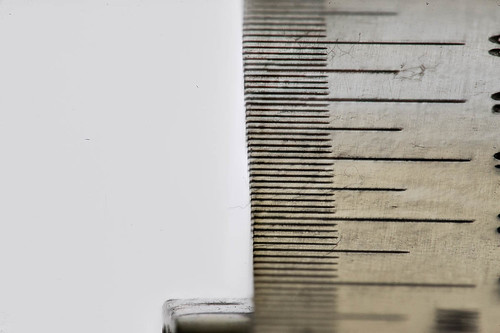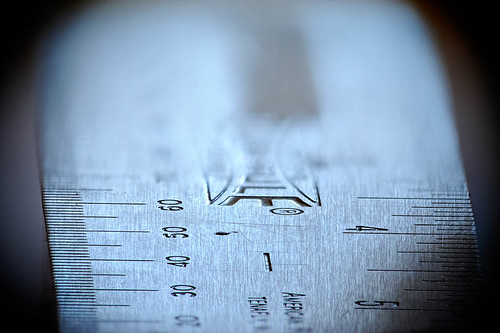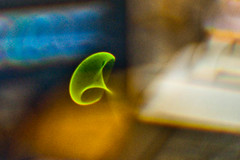Rik, Maybe I should ask in the other threads but this is where you discuss the 38mm telecentric modification. I'd like to try that with my 35mm f/2.8 Canon Macro Photo bellows lens.
If I comprehended the discussions in those threads (big if), here's the formula:
The new aperture goes the same distance as the working distance in front.
The magnification would be determined by making sure I can fit the subject in the diameter of the front element, so 2.4x and that has about a 40mm working distance with about 60mm of extension.
So the aperture would go 40mm behind the back of the lens. The lens design drawing is perfectly symmetrical with, I think it's 6 fixed elements.
The new aperture should be the same size (seems like I may need to eyeball it & do tests to fine tune the actual effective entrance pupil location & size). The lens performs best stopped down from f/2.8 to f/4 so that's no loss for me to stop it down a tad.
Hopefully this won't be telecentric on the rear side or else I'll only get a 15mm dia circle, the diameter of the front element, on my 45mm diagonal FF sensor. Perhaps you cropped the tilted flower example to eliminate vignetting. Perhaps that crop doesn't matter because if this degrades sharpness, a crop would be prudent. Am I right to link this to your other article about how stopping down towards the front is better for image quality than stopping down in back? I might be jumping to conclusions there. It probably depends on the lens <g>.
It sounds likely I'd need to be able to adjust the aperture size and position to actually figure it out
rjlittlefield wrote:Can't recall whether I've mentioned it specifically for the Olympus 38 mm. But it's just another implementation of the general technique illustrated HERE, third image, for the Olympus 80 mm. Stick a limiting aperture at the rear focal point of any lens, and suddenly it becomes telecentric. A ray-traced diagram is shown HERE in the thread on Stopping down a lens combo. There's a bit more discussion in this paper, around pages 14-15.Harold Gough wrote:Rik, I like the way you casually drop that into the discussion. Have you mentioned this elsewhere?
For the 38 mm, the required placement is actually inside the lens barrel, but fortunately still in back of all the lens elements. All I really had to do was cut a disk of black paper with appropriate outside diameter, and put a hole in it to serve as aperture. It's not as good as a commercial telecentric lens, of course, but the paper disk is quite a lot cheaper.
Another method for assembling telecentric optics is shown HERE. That method is considerably more practical at low magnification with longer lenses. But since the discussion about Brian's fuchsia involved an MP-E 65, I thought it would be best to illustrate at higher magnification with a shorter lens. Besides, I already had the aperture disk lying around from earlier experiments.
By the way, the Stopping down a lens combo thread also contains information that's relevant to this discussion about perspective. Firstly, the illustration HERE, second panel, left side, shows that at 4X magnification an ordinary 50 mm lens just doesn't give much perspective effect -- the grid does converge toward the rear, but only slightly. Secondly, the same panel, right side, shows that when used in the obvious way (rear stopped), the lens combo has quite bizarre perspective -- fairly strong and inverted, so background is bigger. This behavior is typical of high mag lens combos, but nobody mentions it. At least I've never seen an article or even a forum posting that says "Stay away from lens combos because the perspective is weird!" With typical subjects, it seems that nobody even notices, and if they do notice, it's not worth commenting about. If perspective were very important, there'd be lots of comments.







